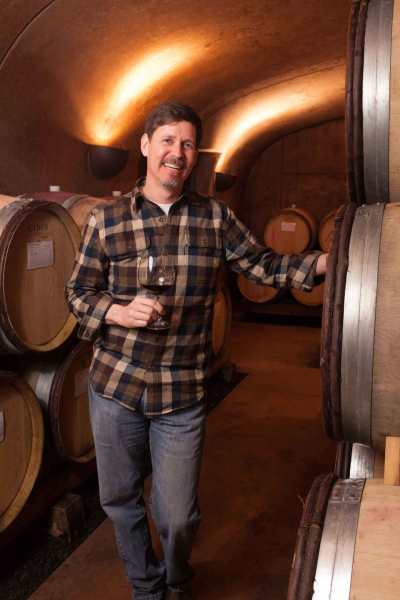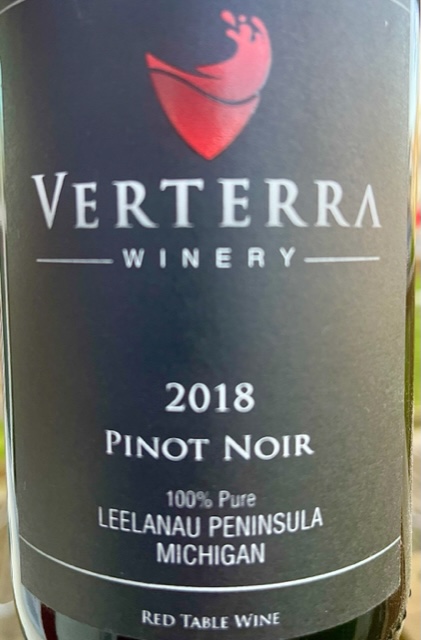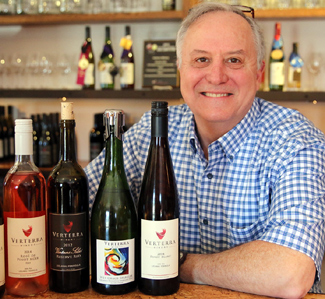Good journalism and writing always demands more sourcing than you can use in a single story. I’ve always tried to conduct as wide-ranging interviews as much as possible with the forum or time constraints of the opportunity.
I did email interviews with the boutique Oregon winemakers I’ve written about in recent weeks. But I also have a great deal of material that didn’t make it into any of the columns.
So here is one long – very long – blog post with some of the highlights from each interview. I thought these were valid and interesting points that didn’t necessarily fit into the stories I wrote. I’m going to present it as concisely as possible in a Q&A format. I included everyone’s answer about aging their Pinot Noir, admittedly a personal interest.
Ghost Hill Cellars
Interviewee Mike Bayliss, owner
The only winery of this group that makes a white Pinot Noir. Why do they make this wine and how has the market reacted?

Drenda and Mike Bayliss
“We wanted to expand the wines we sell in the tasting room. At the time, all that we had planted was Pinot Noir grapes. The Pinot Blanc was suggested to us by a friend who is a French winemaker, who said that half of the French Champagne is made with Pinot Noir Blanc from the youngest planting of Pinot Noir grapes. Our winemaker suggested instead of aging it in oak to use stainless steel to give it a bright crispness to the finish. It’s been very well received in our tasting room and has been well acknowledged by many reviews.”
What is the ageability of Oregon Pinot Noir?
“It depends on the vintage but as an average 8-10 years – plus. Willamette Valley Pinot Noir is always drinkable upon release and especially with local foods.”
What is background of winery?
“The Bayliss Family has been stewards in this corner of the Willamette Valley since 1906. We’re on 240 acres of beautiful rolling hills made up of sedimentary Willakenzie soils … very rewarding for Pinot Noir grapes. We started planting our vineyard in 1999, after we quit farming 200 head of cattle and putting up 250 tons of hay, farming oaks, wheat, and grass hays.”
Alloro Vineyards
Interviewee: Tom Fitzpatrick, winemaker and general manager
Speak about the growing broad appeal of Oregon Chardonnay:

Alloro Vineyards
“I think the appeal of Oregon Chard is the classic ‘cool climate’ profile our wines have. We have just the right climate for this style of Chardonnay, which allow the wines to retain all the subtle and wonderfully complex aromas and flavors, rendered on the almost perfect, complementary frame. These are wines that truly express the terroir and offer up a spectrum of flavors associated with the sites they come from.
“Our style is a wine with a classic cool climate profile with all the wonderful elements that come with barrel fermentation and extended lees contact. This focus and approach delivers a wine with moderate alcohol, bright acidity, a mineral core, fresh pear fruit, and flor aromas. It’s complemented by the barrel fermentation and less contact that bring more fullness and roundness to the palate along with notes of biscuit and baking spices.”

Tom Fitzpatric
Your vineyard is in the northern-most part of the valley. Why is it unique?
“Alloro is a single vineyard site on Laurel Ridge in the Chehalem Mountains AVA. This is a very unique site with a very distinctive personality. My primary focus is to assure the wines capture the distinct personality of this site as they’re expressed in each vintage. I do this by capturing what I call “purity of flavor.” I want the flavors of these wines to be the direct, unencumbered flavor derived from this fruit. There is a very long list of things we do but in a nutshell we undertake activities that mitigate compromise to the integrity of the fruit and undertake activities that mitigate unwanted outside influence on the wines’ flavor. Once in barrel my wines are moved only one time prior to bottling. All movements are either via gravity or with the use of inert gas, all under the protection of inert gas to protect from oxygen exposure. They are bottled after about 11-12 months to capture and retain the richness and purity of fruit and then bottle aged for about one year before the release.”
What is your Pinot’s ageability?
“Our wines see very little oxygen and are handled to retain fruit purity. I believe this dramatically increases their ageability. In general, my wines typically take 2-3 years to blossom and then drink wonderfully for a subsequent 8-plus years.”
Lenne Estate
Interviewee: Steve Lutz, owner
You have a unique vineyard site, explain whys it’s different.
“We farm the vineyard primarily organically but I am not certified organic nor wish to be. I like the flexibility of being able to use other tools if we get into a year with high disease pressure. The way it is going with the weather and early vintages we haven’t had to turn to a commercial fungicide since 2011. We generally just use organic compounds and micronutrients in the vineyard. Our farming is dictated by the year in terms of how we manage the canopy and that is a changing landscape with these warmer evintages.

Steve Lutz
“In the winery we are straight forward unless we get into an unusual vintage. We generally destem and don’t use any whole clusters though I am thinking about playing with it a little this year but it would be totally dictated by the vintage and how developed the stems are. But generally we destem, cold soak and inoculate with yeast. We press before fermentation ends then don’t expose the wine to much oxygen after that unless we have a reduction issue. We sterile filter all our wines and the wines spend 10-11 months in French Oak about 35 percent of which is new.”
When is the best time to drink your Pinot Noir?
“I think the best time to drink most of our vintages is at 10 years out from the vintage. Some vintages take longer and some it is hard to predict their peak. We only started producing in 2004 and so far none of them have oxidized. I think the 2006 wines are at their peak or just past it now for instance. That was a warmer vintage.”
Youngberg Hill
Interviewee: Wayne Bailey, owner and winemaker

Youngberg Inn and event center
Let’s start with your Chardonnay:
“My background in Chardonnay began in Burgundy. I tried for several years to purchase fruit but never found the quality. So we grafted over half of our Aspen Block of Pinot Gris in 2014 and 2015 is our first vintage. My style is that of Burgundy, fermented in barrels (once used) to have the influence of oak but not be oaky. I want to emulate Montrachet.”
How do you describe your approach to Pinot Noir?
“Pinot is the most transparent of any varietal, so my job is to be as light handed in the winery as possible to let that sense of place and vintage shine. That is why making wines from the fruit on our hill is so much fun. We have three distinct soils on our hill, elevations from 500 to 800 feet, and different slopes and orientations. As a result, we make distinctly different wines from each of those distinct ‘terroirs.’ ”
What is the ageability of your Pinot Noir?
“We believe they can age for 20-years plus.”
Vidon
Interviewee: Don Hagge, owner

Don Hagge
I have interviewed Don Hagge on several occasions over the years. I did not ask him a lot in my email interviews like I did the other winemakers. But here are a couple of blog posts and stories featuring the colorful Hagge, wine maker, farmer, student of Burgundy, and NASA engineer.
My visit with Don.
First time meeting Don Hagge










 Oregon’s Willamette Valley has seen explosive growth in recent years in small and large wineries. But big investment from major players has an impact on the smaller wineries distribution and maybe even production.
Oregon’s Willamette Valley has seen explosive growth in recent years in small and large wineries. But big investment from major players has an impact on the smaller wineries distribution and maybe even production.



 Normally the focus is on value wine. But on occasion a look at other prominent wine regions helps with perspective. Additionally, I just returned from leading a wine tour group in Burgundy – my first-ever visit as well.
Normally the focus is on value wine. But on occasion a look at other prominent wine regions helps with perspective. Additionally, I just returned from leading a wine tour group in Burgundy – my first-ever visit as well.






 There are so many to choose from but I strongly recommend two in particular. First, are the Rosé wines from Pinot Noir. Many of the great Oregon Pinot Noir labels are now making a Rosé. More and more California wineries are adding a pink wine to their lineup as well.
There are so many to choose from but I strongly recommend two in particular. First, are the Rosé wines from Pinot Noir. Many of the great Oregon Pinot Noir labels are now making a Rosé. More and more California wineries are adding a pink wine to their lineup as well.